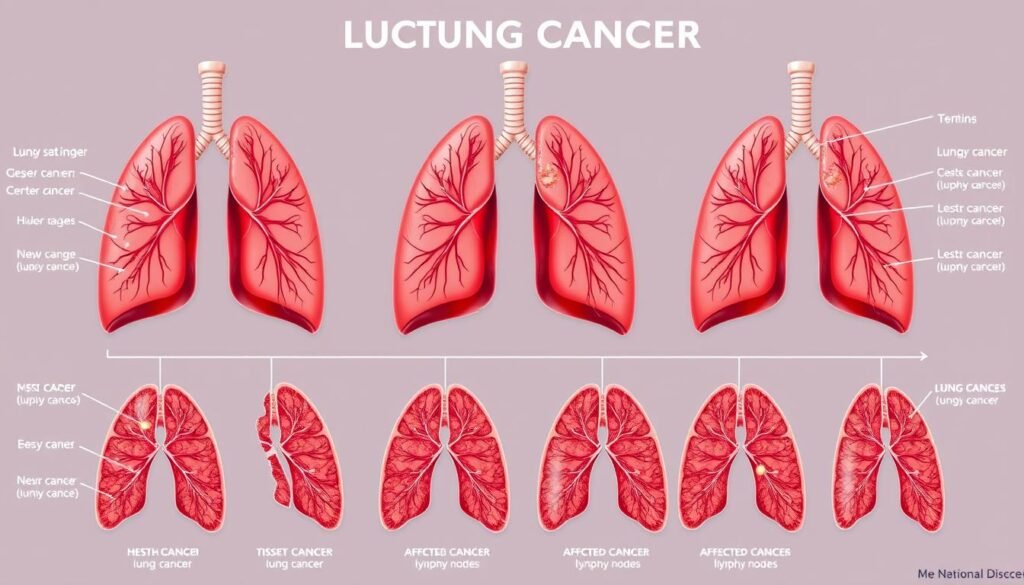Every year, more than 1 million people worldwide die due to lung cancer. About 90% of lung cancer risks are due to cigarette smoking. This shows how tobacco use greatly affects health worldwide, especially in the United States. Here, lung cancer is the top cause of cancer-related deaths.
Men see 31% of cancer deaths, while women have 26%, all from lung cancer in the U.S. This article explores the connection between tobacco use and lung cancer. We look at how tobacco smoke’s carcinogens play a role and why stopping smoking is crucial. Knowing about the harm tobacco causes is key in battling this public health issue.
Key Takeaways
- Tobacco smoking is behind nearly 90% of lung cancer risks globally.
- Over 1 million deaths from lung cancer are seen worldwide each year.
- Smokers are much more likely to get lung cancer than nonsmokers.
- Many lung cancer cases are diagnosed in people who have quit smoking.
- Stopping smoking can lower the chance of getting lung cancer.
- Tobacco use can cause a harmful inflammatory response leading to chronic disease.
The Pervasive Impact of Tobacco Use on Lung Health
Tobacco use greatly harms lung health. It leads to chronic illnesses like chronic obstructive pulmonary disease (COPD). Every year, smoking causes about 6 million early deaths worldwide.
In the UK, smoking is responsible for nearly 96,000 deaths each year. Smokers often live 10 years less than non-smokers.
The toxic substances in cigarettes severely damage lung tissues. This causes chronic inflammation and more respiratory problems. Tobacco use raises the risk of lung cancer and other lung diseases too.
Among people who smoke for years, COPD and similar conditions become more common. This shows the urgent need for effective ways to quit smoking.
Smoking leads to heart attacks and many other health issues. These problems lower the overall quality of life. Secondhand smoke also harms non-smokers, like kids and pregnant women.
Despite years of warnings, 28% of high school seniors still smoke. This shows we must do more to stop young people from starting.
Smoking is a top cause of health problems, including infertility and chronic lung diseases.
For those with COPD or lung cancer, it’s crucial to understand their link. Learning about this connection can help in getting the right diagnosis and treatment quickly.
Understanding Lung Cancer: An Overview
Lung cancer is a major health concern globally, especially because it leads to many deaths. Every year, 1.37 million people die from lung cancer worldwide. In the United States, around 160,000 people die annually from this disease. These deaths are mostly caused by lifestyle and environmental factors. Knowing these facts can help in preventing lung cancer and catching it early.
Statistics on Lung Cancer
Studies show that smoking causes about 80% of lung cancer deaths, making it the biggest risk. Secondhand smoke is also a major cause of lung cancer. This reveals the importance of stopping smoking. Exposure to radon gas and working with asbestos increase lung cancer risks too, especially for smokers.
Current Trends in Lung Cancer Mortality
Deaths from lung cancer are slowly decreasing. This is thanks to less smoking and strong public health messages. Factors like air pollutants and workplace carcinogens also play a role in lung cancer risk. Quitting smoking can greatly lower this risk. Promoting awareness is key in fighting lung cancer. For tips on prevention, visit Mayo Clinic’s lung cancer page.
How Tobacco Use Directly Contributes to Lung Cancer
Tobacco use is a big factor in lung cancer development. It involves complex biological processes. Cigarette smoke has many carcinogens. These can start a chain reaction in lung cells. This often starts when these carcinogens get activated. They then harm the cellular DNA.
The Mechanism of Carcinogen Activation
When inhaled, tobacco carcinogens become active in the body. They change into reactive forms that bind to DNA. This leads to DNA adducts being formed. Such adducts mess with DNA’s normal function. Over time, this increases the chances of gene mutations. Mutations can mess up cell growth and division control pathways. This contributes to lung cancer.
Role of DNA Adducts in Lung Carcinogenesis
DNA adducts play a major role in starting lung cancer. Sometimes, cells can fix this damage. But if DNA adducts can’t be fixed, they cause lasting genetic changes. This sets the stage for cancer. Knowing how DNA adducts relate to lung cancer helps with diagnosis and treatment. This is especially true for squamous cell lung cancer.
In short, tobacco carcinogens and the DNA damage they cause lead straight to lung cancer. More research can help us find better ways to prevent and treat this disease. This knowledge is key to saving lives.
Carcinogens and Toxic Compounds in Tobacco Smoke
Tobacco smoke is filled with thousands of chemicals. Many are harmful and can damage the lungs. Carcinogens in the smoke cause diseases like lung cancer. Knowing about these toxic substances is key to avoiding tobacco’s dangers.
List of Major Carcinogens in Cigarette Smoke
- Acetaldehyde
- Arsenic
- Benzene
- Cadmium
- Formaldehyde
- Hydrazine
- Lead
- Nickel
- Polycyclic aromatic hydrocarbons (PAHs)
- Tobacco-specific nitrosamines (TSNAs)
- Uranium-235
- Polonium-210
Impact of Toxicants on Lung Tissue
Toxic substances in tobacco smoke damage lung tissue. They change how lungs work. Over time, breathing in these chemicals can lead to serious health issues, such as lung cancer.

Cigarettes and cigars share many harmful substances. Even “less harmful” tobacco products, like e-cigarettes, release dangerous chemicals. For example, e-cigarettes have nicotine and other toxins. These substances could cause cancer too.
| Carcinogen | Source | Health Impact |
|---|---|---|
| Acetaldehyde | Tobacco Smoke | Linked to lung cancer and respiratory issues |
| Benzene | Tobacco Smoke | Causes various cancers, affecting blood cells |
| Formaldehyde | Tobacco Smoke | Known carcinogen, contributes to lung tissue damage |
| Polonium-210 | Tobacco Smoke | Radioactive element increasing cancer risk |
| Polycyclic Aromatic Hydrocarbons | Tobacco Smoke | Causes damage to DNA, leading to cancer |
Learning about tobacco smoke’s make-up shows the big health risks from carcinogens and toxins. It proves all tobacco use is a threat to lung health.
Secondhand Smoke Exposure and Its Risks
Secondhand smoke exposure is a big health risk, especially for those who don’t smoke. It’s linked to serious health issues like lung cancer, heart diseases, and breathing problems. More than 7,300 non-smokers die from lung cancer every year in the U.S. because of it.
Both adults and kids face the dangers of risks of passive smoking. For little ones and unborn babies, the risks are even higher. Infants can face sudden infant death syndrome (SIDS). Kids might deal with more asthma, lung infections, and poor lung growth.
The stats on secondhand smoke are shocking. Since 1964, around 2,500,000 non-smokers have died because of it. Each year, about 34,000 deaths from heart disease in non-smokers are linked to tobacco smoke. Being around tobacco smoke can increase the risk of getting lung cancer by 20-30%.
Secondhand smoke has over 7,000 chemicals, including at least 69 that can cause cancer. Efforts to limit smoking in public places aim to protect everyone. This is especially important for those most at risk from tobacco smoke exposure.
Genetic Susceptibility to Tobacco-Induced Lung Cancer
Genes play a big role in the risk of getting lung cancer from smoking. The way our bodies deal with the bad stuff in cigarette smoke relies on our genetics. Some people have gene variations that make them process toxins differently, increasing their lung cancer risk. Studies link certain genes with a higher chance of getting lung cancer among smokers. This shows the deep link between our genes and the danger of smoking.
Influence of Genetic Factors on Cancer Risk
Understanding how genes tie to smoking and lung cancer is key. For example, changes in some genes on chromosome 15 affect nicotine addiction and raise lung cancer risk. These genetic differences change how we react to the toxins in smoke. This research points to the need for personalized ways to evaluate lung cancer risks based on genetics.

Gene changes, like those in the TP53 or BRCA1 genes, play a role in cancer risk when combined with smoking. Our understanding of how genes affect lung cancer risk is growing. It shows the vital role of research in finding those at risk and creating prevention plans that work for them.
The Link Between Chronic Obstructive Pulmonary Disease and Lung Cancer
Chronic obstructive pulmonary disease, or COPD, makes the risk of getting lung cancer higher. Both diseases share common causes like smoking and bad air. It’s key to know how chronic lung issues can lead to cancer.
Inflammatory Pathways Leading to Cancer
Inflammation is crucial in linking COPD to lung cancer. People with COPD often have more oxidative stress in their lungs. This stress can damage DNA and cause mutations.
The presence of harmful species in the lungs adds to this problem. These not only change DNA but also block the body’s defenses. This can cause cells to grow uncontrollably and form tumors.
Studies show smokers with COPD are far more likely to get lung cancer. This fact points out how chronic lung disease can lead to cancer, often with worse results. Plus, COPD greatly harms the life quality of about half of all smokers.
Understanding how COPD and lung cancer are connected is critical. It helps in making ways to prevent and treat these diseases in those affected.
Smoking Cessation Methods to Reduce Cancer Risk
It’s crucial to tackle nicotine addiction to cut lung cancer risk. Various methods help people stop smoking. Knowing these methods gives smokers power to choose their path to health.
Types of Smoking Cessation Aids
There are different aids to help quit smoking. They range in how they work, including:
- Nicotine Replacement Therapies (NRTs) – Gum, patches, and lozenges give nicotine in controlled doses to ease withdrawal.
- Prescription Medications – Medicines like varenicline and bupropion help lessen cravings and withdrawal, raising chances to quit.
- Behavioral Support Programs – Counseling and group support tackle nicotine addiction’s psychological side.
- Self-Help Resources – Books, websites, and apps provide tips and motivation to stay smoke-free.
The Importance of Support in Quitting Smoking
Having support makes a big difference in quitting success. Joining social and professional networks boosts chances to beat nicotine addiction. Studies show:
- Peer-counseling programs work better for quitting smoking among childhood cancer survivors than trying alone.
- People who get professional help are more likely to quit for good.
- Clinical trials are looking into new ways to help smokers quit and live healthier.
Using smoking cessation aids with strong support can greatly reduce lung cancer risk. Quitting smoking is hard, but the benefits are worth it. Improved lung health and lower cancer risk are possible.
Tobacco Marketing Tactics and Their Consequences
Tobacco companies spend a lot to influence people, especially the young. In 2022, they used $8.01 billion on ads. This is like spending almost $22 million every day. This shows they’re working hard to keep their influence and attract new smokers.
Tobacco ads do more than just show the product. In 2021, e-cig ads cost $859.4 million, more than before. Most of this money went to price discounts. They made up 86% of the spending in 2022, which was $6.88 billion. Such deals mainly lure young people by making smoking seem cheap, especially in areas with less money.
Many young smokers choose the brands they see in ads. About 72.1% of them go for the most advertised ones. It shows that ads really affect their choices. Also, tobacco firms push menthol cigarettes a lot. 83.1% of African American youth smokers pick these. This leads to big health problems in some groups, showing the harm of focused ads.
In short, tobacco ads play a big part in getting young people to smoke. They shape what they think and do about smoking. It’s a big problem for those trying to control tobacco use and its health risks.
Lung Cancer Staging and Treatment Options
Lung cancer staging is key to deciding the best treatment and predicting outcomes. It sorts lung cancer into stages from early to advanced. Accurate lung cancer staging helps doctors choose the right lung cancer treatment options for each patient.
Understanding Lung Cancer Staging
Cancer stages are based on tumor size, lymph node involvement, and cancer spread. Early-stage non-small cell lung cancer might only need surgery to remove the tumor. As cancer grows, treatments might include surgery, chemotherapy, radiation, and targeted therapies. These steps help manage the disease better and improve outcomes.
Emerging Targeted Therapies for Lung Cancer
New targeted therapies focus on cancer cells’ specific changes, mainly in NSCLC. They aim to block cancer growth while sparing healthy cells. Together with chemotherapy and immunotherapy, these treatments offer new hope. They help fight lung cancer more effectively, leading to better life quality and survival chances.

Conclusion
The link between smoking and lung cancer is clear from years of research. Each year, about 1.5 million people die worldwide from lung cancer. This huge number shows why we must focus on public health efforts.
Nearly all of these deaths, about 95%, could be avoided. We need to work harder on stopping smoking and teaching people about its dangers. This is especially true for groups that are more at risk for tobacco-related diseases.
It’s very clear that smoking greatly increases the risk of lung cancer. Studies from the 1950s have shown us that heavy smokers are much more likely to die from lung cancer. The risk can be up to 40 times higher.
These shocking numbers show we need to work together to prevent tobacco use. We must have programs that focus on prevention. We also need to help and support those who are trying to stop smoking. This will create a healthier community for everyone.
Finally, with lung cancer deaths expected to rise because of smoking, we need to strengthen public health plans and educate more people. If we can get fewer people to smoke and better promote prevention of lung cancer, we can greatly reduce this disease’s impact. Every single effort in the fight against illnesses caused by tobacco matters. Together, we can create significant health improvements for communities all over the United States.